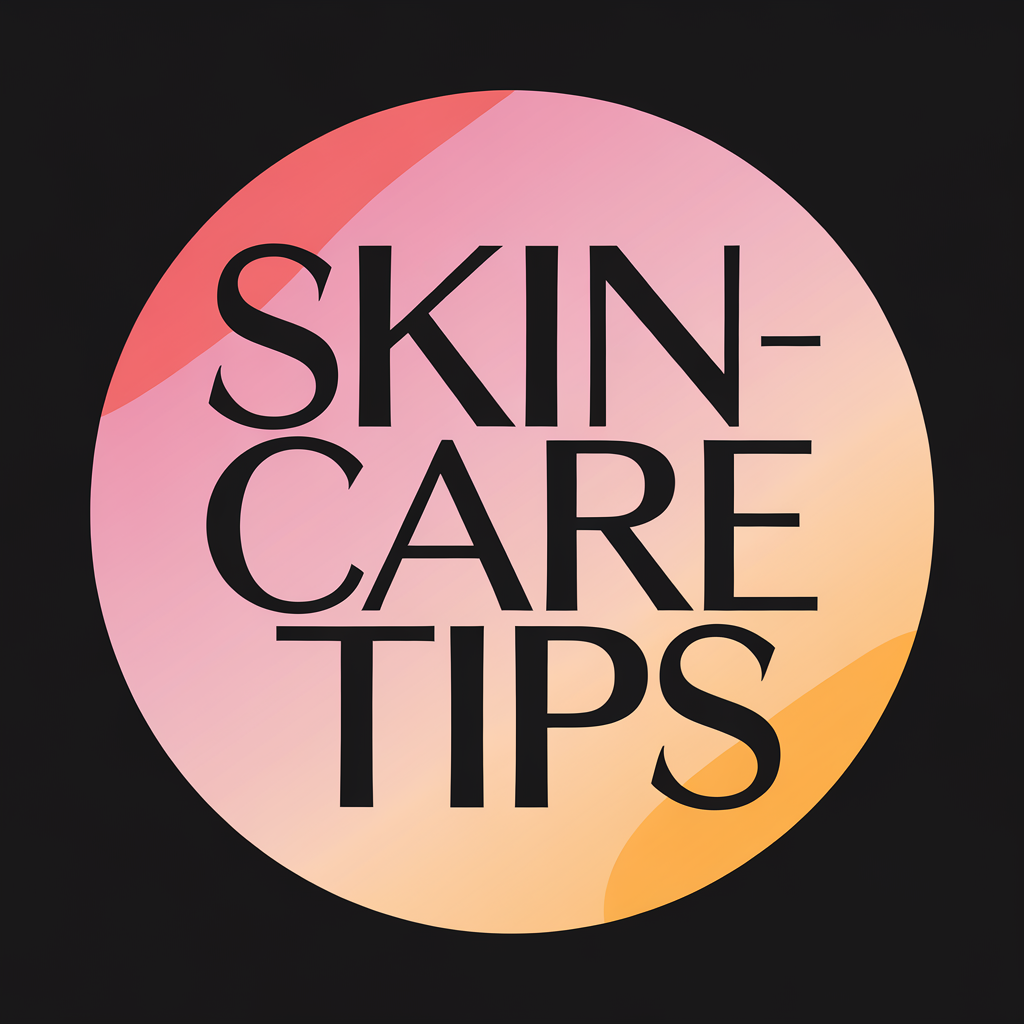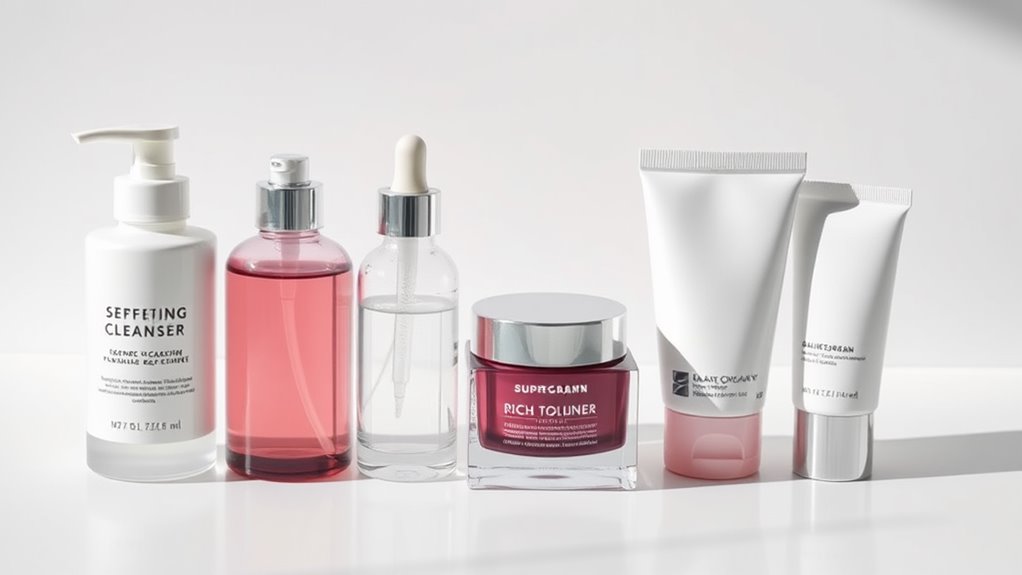The Ultimate Beginner’s Guide to Skincare Layers
You might not realize that the order of your skincare layers directly influences product absorption and skin health. By mastering this sequence, you’ll optimize hydration and protection, so let’s uncover the essentials next.
Key Takeaways
- Apply skincare products in order from thinnest to thickest, starting with cleanser, to maximize absorption.
- Begin with a gentle cleanser to remove dirt and impurities, preparing the skin for subsequent layers.
- Follow with a pH-balanced toner to restore hydration and refine pores after cleansing.
- Layer lightweight serums next for targeted benefits, like hyaluronic acid for moisture or vitamin C for brightening.
- End with moisturizer to seal in hydration and apply broad-spectrum SPF 30+ sunscreen for UV protection.
Understanding Skincare Layers
Have you ever wondered how to build an effective skincare routine?
Understanding how to layer skincare forms the foundation of a successful regimen.
You apply products in a specific order, starting with the lightest, water-based formulas to ensure deep penetration before adding thicker, oil-based ones.
This technique maximizes absorption, prevents product interference, and boosts efficacy.
For instance, you gently pat on serums after toners, allowing each layer to settle without rushing.
Adopting the thinnest to thickest rule can significantly improve absorption and effectiveness in your routine.
Essential Products for Beginners
Now that you’ve mastered layering techniques, identify the core products that build a beginner’s routine.
Start with a gentle, sulfate-free cleanser to remove dirt and excess oil without disrupting your skin’s barrier.
Choose a pH-balanced toner to restore hydration and minimize pores.
A non-comedogenic moisturizer delivers essential nutrients, maintaining your skin’s moisture levels.
Don’t skip broad-spectrum SPF 30+ sunscreen; it shields against UVA and UVB rays, preventing premature aging.
For texture concerns, add a basic exfoliant with AHAs, but keep it simple to avoid irritation.
Focus on these staples for a balanced, effective regimen.
By adhering to these basics, you can achieve radiant and healthy skin.
The Order of Application
Applying skincare products in the correct order maximizes their effectiveness and protects your skin’s barrier.
This sequence allows each layer to penetrate without interference, starting with a gentle cleanser to remove impurities and prepare the surface.
Follow with toner to balance pH and enhance absorption.
Next, apply lightweight serums for targeted active ingredients, such as antioxidants or retinoids, before layering on moisturizer to seal in hydration and strengthen the barrier.
End with sunscreen to shield against UV damage.
Understanding the science behind layering is essential for optimizing the timing between products to achieve maximum effectiveness.
Cleansing Techniques
Before you apply your skincare layers, you must master cleansing techniques to remove impurities effectively and prepare your skin.
You’ll begin with double cleansing basics, a method that involves using two steps for a deeper clean.
Next, we’ll explore cleanser types overview, guiding you to select products based on your skin’s specific needs.
This technique helps unlock radiant skin by ensuring a thorough removal of impurities and preparing the skin for optimal product absorption.
[LIST OF 3 SUBHEADING DISCUSSION POINTS IN ENGLISH
Cleansing techniques form the foundation of any effective skincare routine, with three key aspects to master for optimal results.
You’ll achieve cleaner, healthier skin by focusing on these essentials, avoiding common pitfalls that lead to irritation or dryness.
-
Select the right cleanser: Choose a formula suited to your skin type—oily skins benefit from foaming cleansers that remove excess oil without over-drying, while dry skins need gentle, cream-based options to preserve moisture.
-
Master application methods: Apply cleanser to damp skin and massage gently in upward circles; this lifts impurities efficiently without causing micro-tears or inflammation.
-
Ensure proper rinsing: Use lukewarm water to thoroughly remove all product residues, then pat your skin dry softly to maintain its natural barrier integrity.
Double Cleansing Basics
Double cleansing enhances your routine by tackling stubborn impurities that a single wash often misses.
You’ll begin with an oil-based cleanser to dissolve makeup, sunscreen, and excess sebum, using gentle circular motions to lift debris without irritation.
Follow immediately with a water-based cleanser to rinse away remaining residues, ensuring thorough removal of pollutants and dead skin cells.
This scientifically backed technique maintains your skin’s barrier integrity, minimizes pore congestion, and promotes a balanced microbiome.
As a beginner, you’ll achieve cleaner, healthier skin by making this step a nightly habit, optimizing your overall layering routine.
Cleanser Types Overview
Understanding the various types of cleansers helps you select the right one for your skin’s needs and cleansing techniques.
By matching formulations to your skin type, you’ll remove impurities effectively while maintaining its barrier and pH balance.
-
Gel cleansers: These lightweight, water-based options use mild surfactants to dissolve oil and dirt without residue, making them ideal for oily or acne-prone skin.
-
Cream cleansers: Rich in emollients, they gently cleanse and hydrate, preventing dryness in sensitive or mature skin types.
-
Oil-based cleansers: Formulated with natural oils, they emulsify makeup and sunscreen efficiently, perfect for all skin in double-cleansing routines.
Toners and Their Benefits
Toners play a key role in your skincare routine by restoring the skin’s pH balance and removing residual impurities left after cleansing.
They hydrate your skin, enhancing its barrier function and reducing dryness for a smoother texture.
You’ll find toners packed with ingredients like antioxidants and botanical extracts, which soothe inflammation and combat free radicals.
This step optimizes product absorption, preventing clogged pores and promoting overall health.
Choose alcohol-free options to avoid stripping natural oils, ensuring your skin stays balanced and resilient without irritation.
Always patch test new toners for compatibility.
For an extra glow, consider natural facial toner recipes that use simple ingredients to enhance your routine.
Serums for Skin Treatment
As you advance your skincare routine beyond toners, serums offer targeted treatments that address specific skin issues.
You’ll examine serum types, such as those for hydration or anti-aging, along with their key ingredients like hyaluronic acid or vitamin C.
Mastering application methods ensures you apply these potent formulas effectively for optimal results.
Additionally, hyaluronic acid is renowned for its ability to retain moisture, making it a standout choice for enhancing skin hydration.
Serum Types
Serums deliver potent, targeted treatments to address specific skin concerns, making them a key step in your routine.
You’ll encounter various serum types that optimize your skin’s health based on its needs.
-
Hydrating serums: These boost moisture levels, fortifying your skin’s barrier and preventing dryness for a plump, resilient complexion.
-
Anti-aging serums: They combat wrinkles and loss of elasticity, stimulating collagen production to maintain a youthful appearance.
-
Brightening serums: These even out your skin tone, reducing dullness and promoting a radiant, uniform glow.
Choose the right type to enhance your routine’s effectiveness.
Key Ingredients
Key ingredients form the backbone of effective serums, delivering targeted treatments that address your skin’s specific needs.
Hyaluronic acid provides superior hydration by attracting and retaining moisture, combating dryness and promoting a supple texture.
Vitamin C neutralizes free radicals, brightens your complexion, and boosts collagen for a youthful glow.
Retinol accelerates cell turnover, reducing wrinkles and evening skin tone through proven anti-aging mechanisms.
Niacinamide strengthens your barrier, controls oil, and minimizes pores, offering anti-inflammatory relief.
Peptides enhance firmness by stimulating collagen production, ensuring long-term resilience.
Select based on your skin’s unique requirements for optimal results.
Application Methods
Applying serums correctly transforms their potent ingredients into visible results for your skin.
By following precise methods, you enhance efficacy, reduce irritation, and ensure deep penetration of active compounds like hyaluronic acid or vitamin C.
- Cleanse first: Start with a gentle, pH-balanced cleanser to remove debris, allowing serums to penetrate barriers and maximize nutrient delivery.
- Apply gently: Use your fingertips to pat a few drops onto damp skin; this technique boosts absorption without causing micro-damage, optimizing ingredient efficacy.
- Wait and layer: Allow 1-2 minutes for full absorption before adding moisturizer, preventing dilution and locking in benefits for sustained skin health.
Moisturizers and Hydration Tips
Moisturizers seal in the hydration your skin needs to stay healthy and resilient. You select one based on your skin type: opt for lightweight, water-based formulas if you’re oily, or thicker creams if dry.
Key ingredients like hyaluronic acid draw moisture in, while occlusives such as petrolatum lock it down, strengthening your skin’s barrier.
To hydrate effectively, apply moisturizer twice daily on damp skin post-cleansing for optimal absorption.
Drink ample water and incorporate humectant serums to boost internal hydration.
Monitor for irritation; adjust as needed for balanced, glowing results.
Always patch test new products.
To make the best choice, begin by identifying your skin type.
Sunscreen in Your Routine
Sunscreen forms the final, crucial layer in your skincare routine, shielding your skin from damaging UV rays that cause premature aging and increase cancer risk.
It’s essential for daily protection, blocking UVA rays that penetrate deeply to cause wrinkles and UVB rays that lead to burns, thus preserving your skin’s barrier and reducing long-term damage.
- Select broad-spectrum SPF 30+: Choose formulas that protect against both UVA and UVB rays, opting for water-resistant options for active days.
- Apply generously: Use about a teaspoon for your face and neck, ensuring even coverage as the last morning step before makeup.
- Reapply regularly: Do so every two hours outdoors or after sweating/swimming to maintain efficacy and prevent UV accumulation.
For the best results, incorporate timing recommendations into your daily routine.
Eye and Lip Care Essentials
After protecting your skin with sunscreen, you can’t overlook the delicate areas around your eyes and lips, which need targeted products to fend off wrinkles, dryness, and UV effects while boosting hydration and barrier strength.
Opt for an eye cream with hyaluronic acid and peptides to minimize fine lines and inflammation, applying it gently with your ring finger.
For lips, select a nourishing balm containing shea butter and SPF to lock in moisture and protect against environmental stressors.
These essentials enhance elasticity, reduce irritation, and fortify your skin’s defenses for lasting resilience.
Additionally, hyaluronic acid serves as a key ingredient that dermatologists recommend for its ability to provide deep hydration, making it the most effective hydrating compound for maintaining skin health.
Customizing Layers for Your Skin Type
You assess your skin type first by evaluating factors like oiliness, dryness, or sensitivity, as this forms the foundation of an effective routine.
Once you’ve identified your skin’s needs, you adjust the layers of your skincare regimen to include products that address specific concerns, such as lighter formulas for oily skin.
This tailored approach ensures you achieve optimal results while minimizing irritation or overuse.
For a more precise evaluation, consider performing an at-home test to determine if your skin is oily, dry, combination, or normal.
Assess Skin Type
Understanding your skin type is essential for tailoring an effective skincare routine, as it determines how products interact with your face.
You’ll need to evaluate key characteristics like oiliness, dryness, and sensitivity through observation and simple tests.
-
Observe oil levels: Press a tissue to your face; excess oil transfer indicates oily skin, while none suggests dry or normal types.
-
Assess hydration: Notice if your skin feels tight or flaky after cleansing, pointing to dehydration or dry skin.
-
Check reactions: Apply a new product and monitor for redness, itching, or breakouts to identify sensitive skin accurately.
Adjust Layers Accordingly
How can you effectively customize your skincare layers for your skin type? Start by identifying your skin’s needs—oily, dry, combination, sensitive, or normal—and adjust product weights and actives accordingly. For instance, prioritize lightweight, non-comedogenic layers for oily skin to control shine, while dry skin benefits from richer emollients for barrier repair.
| Skin Type | Recommended Adjustments |
|---|---|
| Oily | Use oil-free cleansers and light gels. |
| Dry | Add hydrating serums and thick creams. |
| Combination | Target T-zone with mattifiers. |
| Sensitive | Choose fragrance-free, soothing layers. |
| Normal | Maintain balanced, standard routines. |
Tailoring these ensures efficacy, preventing irritation and promoting health. Always patch-test new products for best results.

